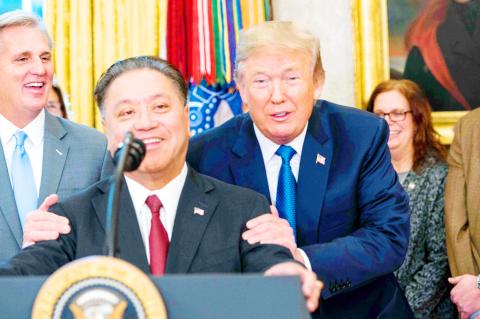Qualcomm Inc said its board will convene to discuss the next steps on Broadcom Ltd’s US$121 billion acquisition offer after a meeting with its hostile suitor on Wednesday, giving no indication of whether the two chipmakers are closer to agreeing on the largest deal in the history of technology.
“We met with representatives of Broadcom for two hours earlier today, and listened carefully to what they had to say,” Qualcomm said in a statement after the meeting in New York. “The Qualcomm board will promptly meet to discuss the meeting and to determine next steps.”
While Qualcomm’s representatives listened, they did not engage with their counterparts, according to a person familiar with Broadcom’s view of how the meeting went.

Photo: AFP
Last week, Qualcomm’s board rejected Broadcom’s “best and final” proposal of US$82 a share, which San Diego-based Qualcomm has dismissed as too low. The company had agreed to meet with Broadcom chief executive officer Hock Tan (陳福陽), but warned that he would need to offer more and give better assurances that a transaction would get regulatory approval in a reasonable time frame. Tan replied that the newest bid was as high as he was going to go.
The two sides face a showdown at a March 6 shareholder meeting, where Broadcom is asking Qualcomm investors to elect its board nominees in order to force the deal through.
A failure to win over either Qualcomm’s board or shareholders would be a rare setback for Tan. He has already made Broadcom into one of the largest companies in the US$380 billion semiconductor industry through a string of deals. Taking control of Qualcomm, the biggest maker of chips that power smartphones, would give his company an unprecedented reach in the components that run modern communications systems.
Qualcomm’s board includes chairman Paul Jacobs — the son of the company’s founder — and CEO Steve Mollenkopf, who are both engineers committed to taking market-leading mobile chip technology into new areas such as servers, personal computers and automobiles. Tan has dismissed such expansion plans as unrealistic, arguing that the industry has changed and slowed down.
At the meeting, Tan was not given the chance to appeal to the whole of Qualcomm’s board. The target company was represented by Tom Horton, Jacobs and Mollenkopf from the board, and three others from the leadership team. Only Horton is an independent; the rest are long-serving executives, or, in Jacobs’s case, a former executive, who are committed to Qualcomm’s current strategy and plan to remain a standalone company.
Still, Qualcomm’s contention that the chipmaker’s future is brighter on its own has been a tough sell over the past two years. Challenges to the lucrative technology-licensing business have been at the center of its problems.
Regulators around the world are fining or investigating Qualcomm, supporting elements of Apple Inc.’s claims in a lawsuit alleging Qualcomm abuses its dominant position in mobile chips. Qualcomm has countered that it expects to win in court over time and overturn some of the more than US$4 billion it has been fined.

Intel Corp chief executive officer Lip-Bu Tan (陳立武) is expected to meet with Taiwanese suppliers next month in conjunction with the opening of the Computex Taipei trade show, supply chain sources said on Monday. The visit, the first for Tan to Taiwan since assuming his new post last month, would be aimed at enhancing Intel’s ties with suppliers in Taiwan as he attempts to help turn around the struggling US chipmaker, the sources said. Tan is to hold a banquet to celebrate Intel’s 40-year presence in Taiwan before Computex opens on May 20 and invite dozens of Taiwanese suppliers to exchange views

Application-specific integrated circuit designer Faraday Technology Corp (智原) yesterday said that although revenue this quarter would decline 30 percent from last quarter, it retained its full-year forecast of revenue growth of 100 percent. The company attributed the quarterly drop to a slowdown in customers’ production of chips using Faraday’s advanced packaging technology. The company is still confident about its revenue growth this year, given its strong “design-win” — or the projects it won to help customers design their chips, Faraday president Steve Wang (王國雍) told an online earnings conference. “The design-win this year is better than we expected. We believe we will win

Chizuko Kimura has become the first female sushi chef in the world to win a Michelin star, fulfilling a promise she made to her dying husband to continue his legacy. The 54-year-old Japanese chef regained the Michelin star her late husband, Shunei Kimura, won three years ago for their Sushi Shunei restaurant in Paris. For Shunei Kimura, the star was a dream come true. However, the joy was short-lived. He died from cancer just three months later in June 2022. He was 65. The following year, the restaurant in the heart of Montmartre lost its star rating. Chizuko Kimura insisted that the new star is still down

While China’s leaders use their economic and political might to fight US President Donald Trump’s trade war “to the end,” its army of social media soldiers are embarking on a more humorous campaign online. Trump’s tariff blitz has seen Washington and Beijing impose eye-watering duties on imports from the other, fanning a standoff between the economic superpowers that has sparked global recession fears and sent markets into a tailspin. Trump says his policy is a response to years of being “ripped off” by other countries and aims to bring manufacturing to the US, forcing companies to employ US workers. However, China’s online warriors